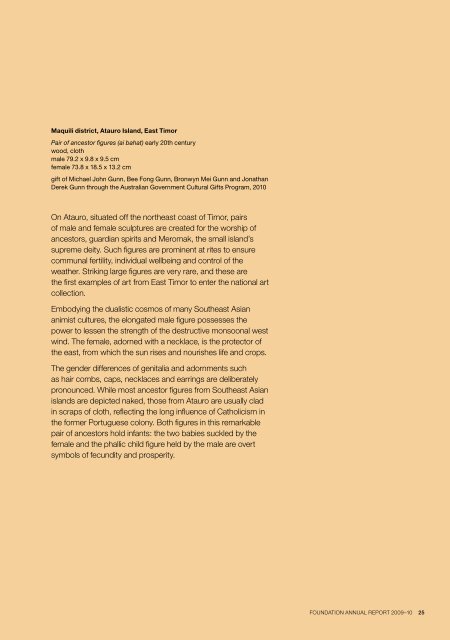foundation annual report 2009â10 - National Gallery of Australia
foundation annual report 2009â10 - National Gallery of Australia
foundation annual report 2009â10 - National Gallery of Australia
Create successful ePaper yourself
Turn your PDF publications into a flip-book with our unique Google optimized e-Paper software.
Maquili district, Atauro Island, East Timor<br />
Pair <strong>of</strong> ancestor figures (ai bahat) early 20th century<br />
wood, cloth<br />
male 79.2 x 9.8 x 9.5 cm<br />
female 73.8 x 18.5 x 13.2 cm<br />
gift <strong>of</strong> Michael John Gunn, Bee Fong Gunn, Bronwyn Mei Gunn and Jonathan<br />
Derek Gunn through the <strong>Australia</strong>n Government Cultural Gifts Program, 2010<br />
On Atauro, situated <strong>of</strong>f the northeast coast <strong>of</strong> Timor, pairs<br />
<strong>of</strong> male and female sculptures are created for the worship <strong>of</strong><br />
ancestors, guardian spirits and Meromak, the small island’s<br />
supreme deity. Such figures are prominent at rites to ensure<br />
communal fertility, individual wellbeing and control <strong>of</strong> the<br />
weather. Striking large figures are very rare, and these are<br />
the first examples <strong>of</strong> art from East Timor to enter the national art<br />
collection.<br />
Embodying the dualistic cosmos <strong>of</strong> many Southeast Asian<br />
animist cultures, the elongated male figure possesses the<br />
power to lessen the strength <strong>of</strong> the destructive monsoonal west<br />
wind. The female, adorned with a necklace, is the protector <strong>of</strong><br />
the east, from which the sun rises and nourishes life and crops.<br />
The gender differences <strong>of</strong> genitalia and adornments such<br />
as hair combs, caps, necklaces and earrings are deliberately<br />
pronounced. While most ancestor figures from Southeast Asian<br />
islands are depicted naked, those from Atauro are usually clad<br />
in scraps <strong>of</strong> cloth, reflecting the long influence <strong>of</strong> Catholicism in<br />
the former Portuguese colony. Both figures in this remarkable<br />
pair <strong>of</strong> ancestors hold infants: the two babies suckled by the<br />
female and the phallic child figure held by the male are overt<br />
symbols <strong>of</strong> fecundity and prosperity.<br />
FOUNDATION ANNUAL REPORT 2009–10 25
















